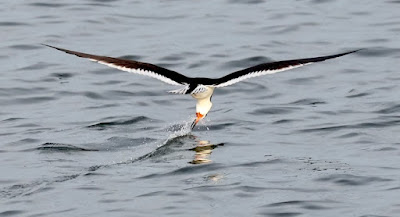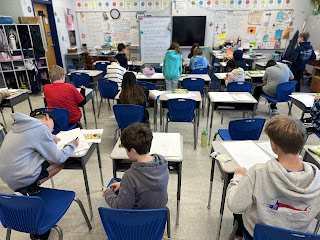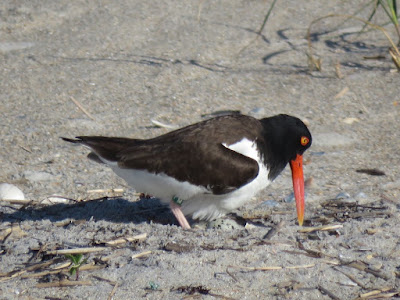February 23
Wrightsville Beach Elementary School 5th Graders
Create Signs for the Posting
April 4
Posting Goes Up
April 21
All of these birds in the posting make a nest out of sand and are referred to as “beach-nesting birds.” They also nest in large groups called “colonies.”
For example…the black ones you see right away on the sand are called Black Skimmers. They are a beautiful bird and unique because they actually “skim” the surface of the water to fish.
They recently arrived here on the south end! They winter in the Caribbean and the southeastern U.S. Many are tired and you will see them in a very distinctive resting posture where they are lying flat on the sand. They are beginning to pair up and courtship activities will begin soon.
What are those little birds in front of the skimmers…in the sand with all the shells?
The little birds are called Least Terns.
Least Terns arrived first and are now in courtship mode and some have begun nesting on the sand. You will see male Least Terns presenting fish to females in hopes of finding a mate. The female tern evaluates these fish presentations to see if that male has the fishing skills to feed her chicks. Least Tern chicks must swallow fish whole…so little fish are needed as soon as the chicks hatch…and bigger fish are needed as the chicks grow. (Parent birds do not regurgitate food to feed these little chicks.)
Did the Least Terns travel too?
Yes, they travel long distances, migrating from the Caribbean and the northern coast of South America to nest here.
So why is the area posted?
Migratory birds are protected by law from harassment and harm. These particular birds make nests right on the sand and often people don’t realize what they are doing here. Without the posting, people would walk through the nesting area, and the adults would fly up and be separated from their eggs or chicks. Without parents to take care of them, eggs and chicks will overheat or be eaten by predators. The eggs and chicks are also very well camouflaged so people can also step on them if they go into the posting.
When will the chicks hatch?
We expect chicks by the first week of June if all goes well.
May 6
FREE MONDAY BIRD WALKS
Our weekly Monday Bird Walks for the general public started May 5th. Walks meet at 9 AM at the gazebo at Beach Access 43. They happen every Monday from May through mid-August.
What is there to see now?
We have a large number of Black Skimmers, and many are doing courtship behaviors. These include fish presentations, scraping (making their nest), pair bonding displays (coordinated movements and standing near each other), and actually mating. Once a pair has eggs in their scrape, you can watch them incubate by sitting down in the scrape and swap out incubation shifts.
Don’t miss the hundreds of Least Terns. Many people’s eyes skip over them because of how well they blend into the shells on the sand in the front area of the posting.
Sharing incubation duties
What you may find most interesting during your time on the beach is observing the shared nesting and chick rearing behaviors of these birds. Besides the fact that the male and female look the same (both beautiful in our opinion!), the couples bond with physical closeness during egg laying and shared responsibility of incubating the eggs, feeding the chicks, and protecting and guiding them as they near fledging. Beach-nesting birds have excellent parenting skills!
This week, unfortunately, the oystercatcher pair lost their nest. They were last seen incubating on Monday evening at dusk, and on Tuesday morning they were no longer incubating. We confirmed there were no longer eggs later in the day. We don’t know what happened, but there were no human or mammal tracks at the nest. They will likely renest in a week or so, so keep a close eye on them!
FIELD-READABLE BANDS
Oystercatchers banded in North Carolina by Lindsay Addison and her team are banded with a GREEN band. A few examples of colors from other states include...
Red: GA or FL, Black: VA, Blue: SC
One of the Oystercatchers nesting on the north end of Wrightsville has a red band.
If you see an Oystercatcher with a band, take a photo and report it to www.amoywg.org
Black Skimmers banded in North Carolina by Lindsay and her team are banded with a BLACK band with white letters.
A Black Skimmer is in our nesting colony with a white band with black letters. It was seen Sunday afternoon displaying courtship behavior. A WBBS volunteer took a photo and we reported it to the www.reportband.gov site and learned it was from Virginia!
A few examples of colors from other states of Black Skimmer bands include…
Blue: NJ, Yellow: NY, White: VA or GA, Green: FL
Common Tern
The Argentinian Common Tern with an orange flag on its left leg is back and has mated!






























































